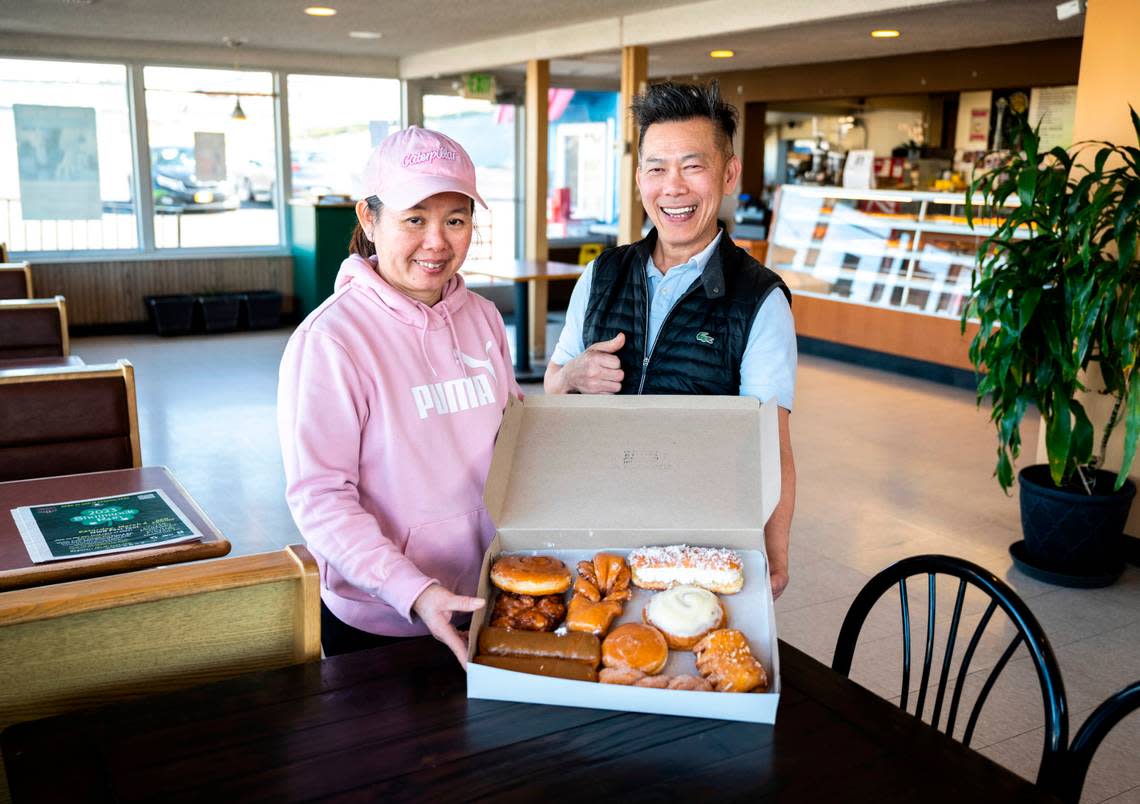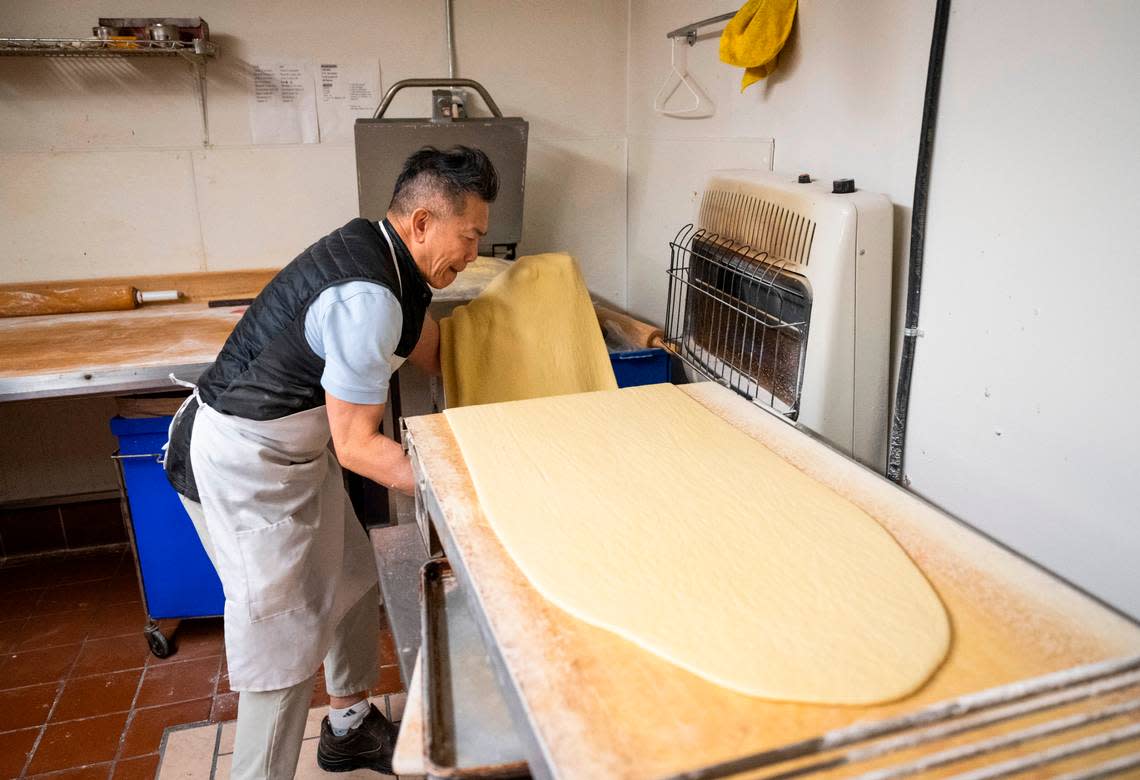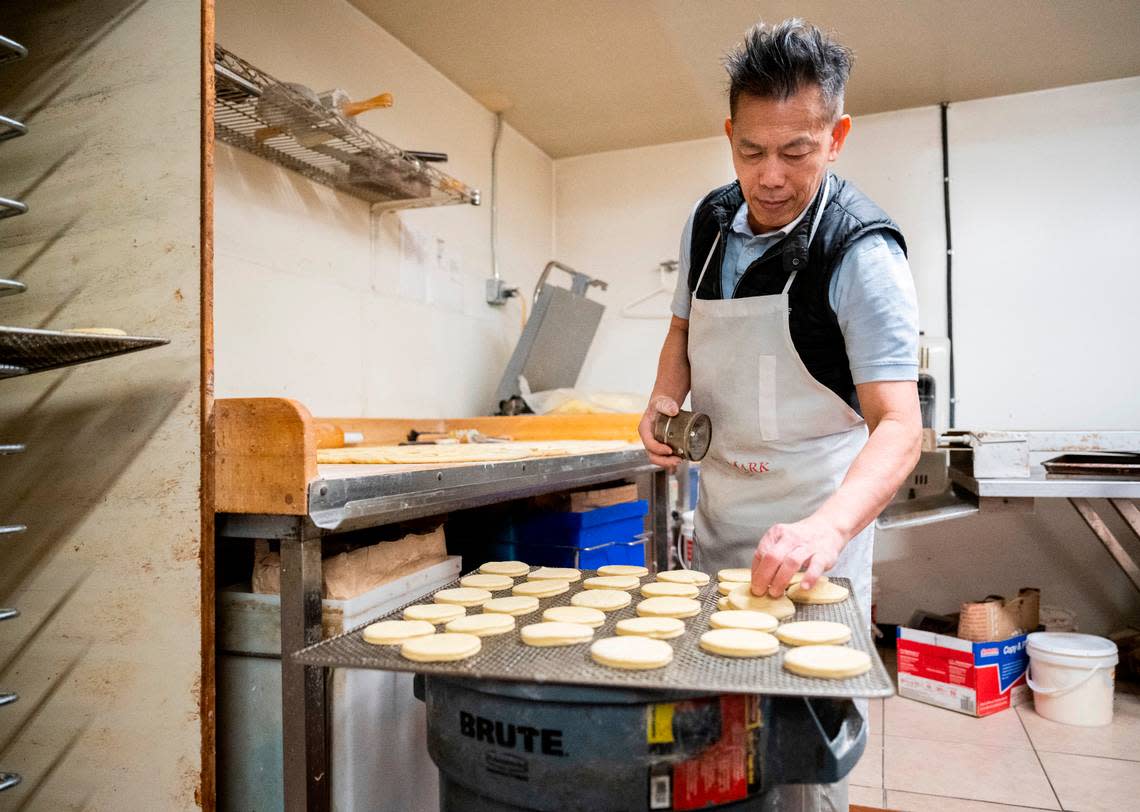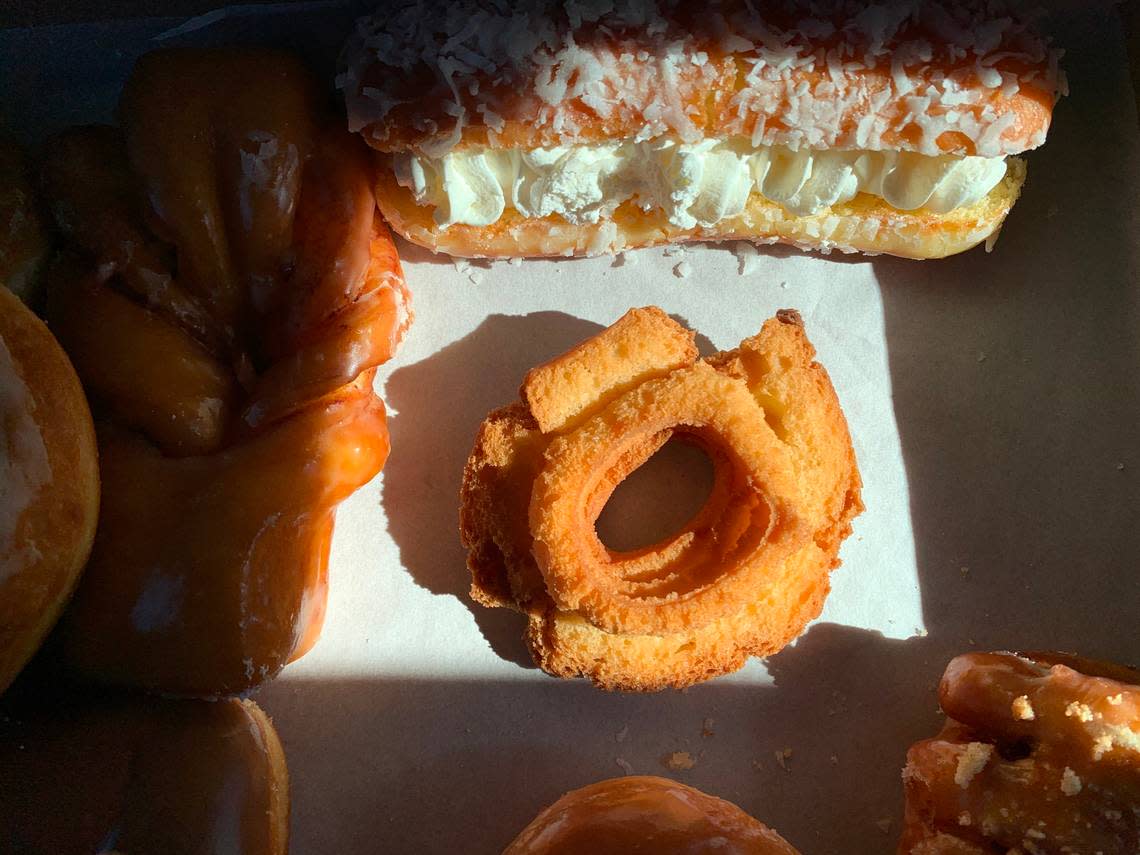From 10 to 10, this doughnut shop doesn’t stop. The TNT spent a morning watching the magic
On Fridays, Round 3 of the daily doughnut routine begins around 5 a.m.
At this point, Sam Yam already has clocked a full day’s work, having churned the first batch of dough at 10 p.m. the night prior. He is here every day — as he has been for the past 13 years since opening his shop on an industrial street between downtown and the Port of Tacoma.
Born in Cambodia, Yam and his family came to the United States as refugees some 40 years ago. The 61-year-old has been making doughnuts since 1985, beginning with his father’s shop in Philadelphia. He and his brother also owned shops in California before Yam moved to Tacoma, where he and his wife Kay Oeng have raised two children.
She arrived at 3:30 a.m. on this Friday in February to pack pre-ordered dozens and serve customers who know the drive-through at Dockside Donuts is open after midnight with hot coffee and fresh-from-the-fryer rounds, rolls and bars.
You voted this Tacoma doughnut shop the best. Our food writer says this one is better
They are joined by one employee, a young man named Brian, who also began his shift the night before. While Yam forms each and every doughnut, his assistant handles most of the frying and topping. As needed, Brian pops up front to support Oeng, whose ability to multitask — from making espresso to taking drive-thru orders on a headset and calling for refills on the old-fashioneds and apple fritters — would put a triage nurse to bed.

Yam almost turned Cheyenne Boone, our photographer, and me away that morning. One of their front-of-house employees had called in sick.
“It happens,” said Yam, but on a Friday?
He pointed to the stacks of white boxes, each hand-stamped with the shop’s name, address and phone number in blue ink, towering from waist-high counter to ceiling, several rows across and deep. Those are all pre-orders, he said, about 70 dozen. Another 30 dozen had already been picked up.
I asked where they were headed. He said he didn’t know. “We don’t have time to know!”
By 6:30, the morning crowd was pulsing.
“OK, OK,” Oeng said through the headset to the driver of a blue pickup truck, an empty box in one hand and long metal tongs in the other. “How about make it a dozen?” she asked. Pausing for a beat, she smiled. “Maple bars, angel bars — how many do you want?”
The front door clattered open every 30 seconds, four to five people always waiting their turn, surprisingly patiently considering the hour.
Yam plopped a mass of dough onto the wooden workbench, pressing it with a rolling pin. He moved it to the right, to a four-foot-tall machine, a compressor that pushes air out of the dough. He closed the hatch and clicked the switch. It rumbled. He opened it, flipped the dough and clicked the switch again. He transferred the mass to the workbench and pressed it lightly with his fingertips. From there it went to the sheeter, a 12-foot-long machine that whirs — in a matter of seconds — the wad back and forth until it’s barely a quarter-inch thick and at least 6 feet long. Yam let one end tip over the edge, cradling the dough on his left forearm; the rest slid off the conveyor and, somehow, onto his right arm. He turned and laid it back on the workbench.
That batch became bars, cut by hand with a tool that looks like a rolling pin but with a large, metal cylinder in the middle.

“When you watch it, it looks easy,” he said, pressing with purpose, “but it’s not easy.”
He yelled to Oeng, on the other side of the wall. He asked us: “What time is it?” Cheyenne looked at her phone. “It’s about 7:30,” she replied.
His 17-year-old son should be here, he explained. He points to the boxes. The teenager (and the Dockside delivery driver every Thursday and Friday) arrived a few minutes later, the stack he’s carrying out the back door to the trunk of a Prius growing taller with each trip. Meanwhile, a young woman, seemingly on a mission, walked through the same door. Cheyenne and I wondered if she was the missing employee.
Within 30 seconds of entering the store, the couple’s 22-year-old daughter had put down her bag and looked to the other side of the counter: “Can I help who’s next?”
She has another job she’ll head to later, she told a regular. She’s also in school, Yam added.
The energy of the shop has shifted. Like water lapping onto the rocky lakefront, steps from where you pitched your tent last night, the early-morning rush was calm, deliberate. The sun was fully up now. As the clock inched toward 8 a.m., doughnut-seekers were in a hurry.
Yam took another mass of dough and repeated the process. Instead of cutting first, he spread cream cheese on one half and raspberry jelly on the other, folded the dough in thirds and used a dough scraper to cut bars one by one. Laying each on a tray, he then took each bar in his hands and quickly pressed his thumb through the dough and pulled it through. Next is the cinnamon-apple flavor.
“I hate these ones!” he said, laughing. Bowties involve more steps than most of the other styles.
I asked if filling the jelly rounds takes such time, too. He looked me in the eye and said, “No, that’s easy!”

The trays of bowties replaced classic yeasted rounds in the proofer. The latter were almost ready for their bath.
The palm oil began to bubble. Brian dunked the tray into the fryer, then flipped the doughnuts with oversized cooking sticks (doughnut turning sticks, they’re called).
After pulling them from the fryer, he doused some in glaze by placing them on a grid over a stainless steel tub — a messy but necessary setup to canvas the whole doughnut — and tossed others in a bin of finely granulated sugar. He glanced toward the front case, doing quick mental math. “At this point in the morning,” he said, “It’s kind of a guessing game.” Coconut usually pulls ahead.
Yam insisted we try one, warm. “Sugar or glazed?” He handed me two pieces of parchment paper before returning his focus to the workbench.
In the 120 minutes we’d been at Dockside Donuts, Yam made hundreds: raised rounds with a hole in the middle, jelly-filled, bars, bowties, then cinnamon rolls, cinnamon-apple bear claws and finally, apple fritters, constructed from the scraps laced with cinnamon and apple. He emphatically chopped the dough with a scraper, with equal abandon and attention. Each portion was balled and pressed by hand into a 2-inch disc. He pulled little bits up here and there, which he said proffer those crunchy, crispy bits you want from a fritter. Dusting flour onto the scraper every time, he shuttled them to a tray to rest before their fry.

Then, it was the end of Round 3. The only thing left was cleanup, and the methodical late-morning-to-afternoon sale of the remains of the day.
“Fritters?” Oeng called from the front. Yam shuffled to the hallway, where trays of doughnuts await their turn in the display case. “They just made them,” their daughter informed the customer.
Leaving Yam time to prepare the bakery for his 10 p.m. return that night, we agreed to come back around noon for an on-camera interview. By then, the case was decimated.
Saturday would be another busy day at Dockside Donuts.
